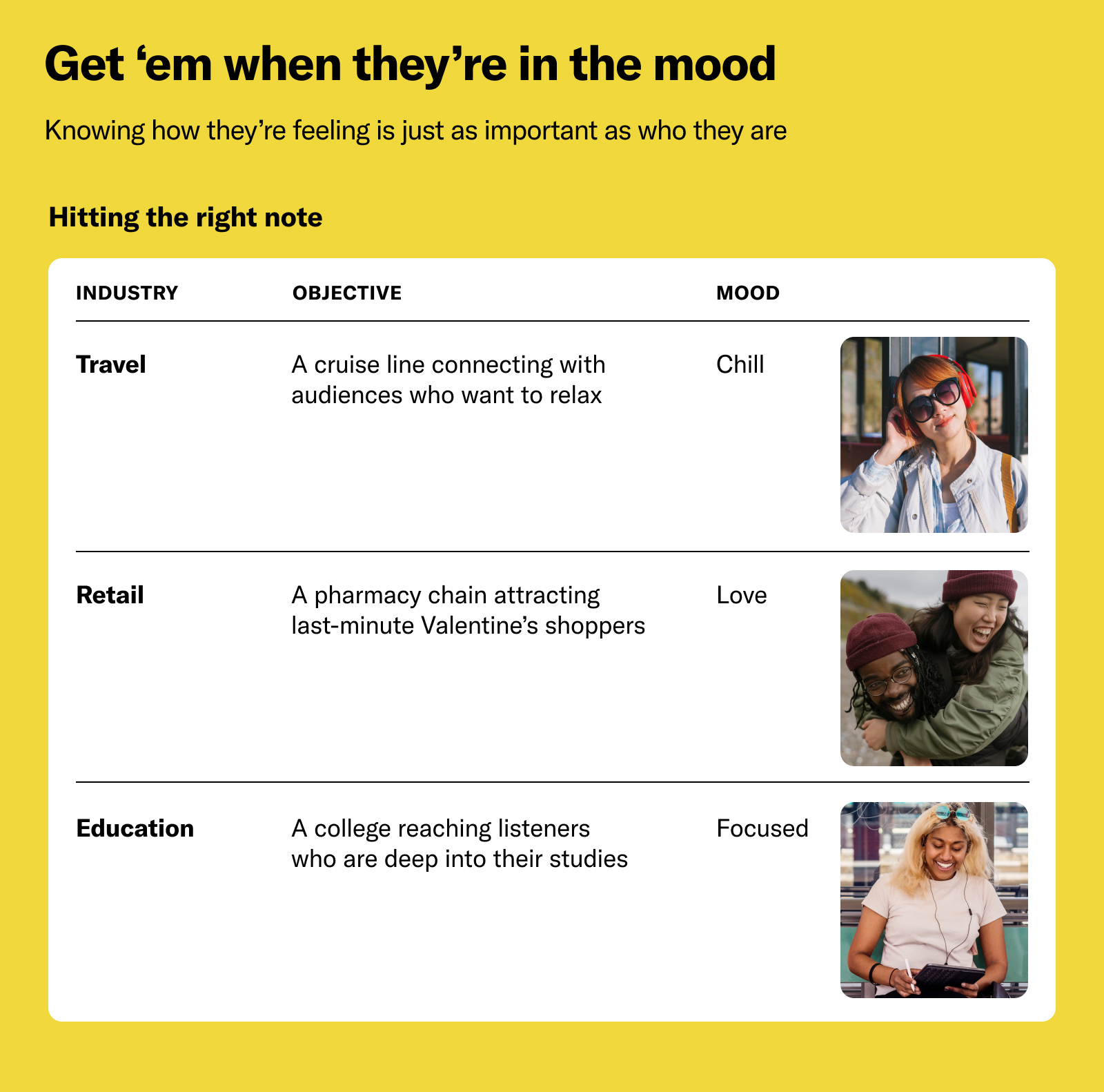What's the Vibe? How Mood Targeting Improves Your Ad Timing.
Apr 17, 2024You’ve got an awesome new product. You know millennial men will love it. And it’s the kind of thing they’re most likely to need mid-day. So, you’re understandably excited to pitch it to this demographic. But what happens when your high-energy ad reaches those millennial men when they just want to chill?
As the saying goes: Context is everything. And that’s where mood targeting comes in to save the day (and your campaign).
A Sitch in Time: Mood Informs Ad Timing
Our mood targeting is a contextual solution that allows brands to better understand the situations and emotions their ads are likely to play into, which can help you get everything from audience, to timing, to messaging right.
Music plays a powerful role in peoples’ lives. Over seven in 10 listeners say music improves their mood, relaxes them, or makes them happy. And over half say it motivates them or helps them focus. With mood targeting, you can meet audiences where they are with messages that are more likely to get attention and inspire action.
Barking Up the Right Tree: Align Brand Messages to Audience
As consumers become savvier about controlling or limiting access to their identifying information, brands will need to pivot their digital advertising strategies. Mood targeting is a privacy-forward, data-driven solution that can standalone or enhance other targeting solutions. Pandora music analysts use art and science to analyze songs and associate them with dominant moods.
Remember that millennial dude who just wants to chill? With mood targeting, you can use our chill mood to reach him with ads that speak to his state of mind. That’s what mood targeting does, it enhances your ability to reach and resonate with your ideal consumers.
Rain or Shine: Reach Audiences with the Right Message
You don’t have to limit yourself to one mood to promote your brand or your products. One ad might work for both happy and celebratory mood targeting. But why not use different ad creative for listeners who are feeling angsty and another for those in a more serene headspace? Just as advertisers might tweak or overhaul creative to reach certain demographics or markets, the same goes for mood. For example, a CPG brand might develop an ad for a new line of body washes to promote its invigorating scents to target the energetic mood, an ad promoting the line's all-natural ingredients for the soothing mood, and yet another ad about how soft it makes skin feel for the love mood.
All of this and more is possible when you work with our in-house audio agency, Studio Resonate. Working with an audio agency can help you craft custom ads that fit the vibe (no matter what it is).
Birds of a Feather: Put Your Ads in Context
Mood targeting isn’t just about getting your ad into the context of the right content. There is also an opportunity for brands to build ads that feel integrated into the content they support. And understanding the type of music the audiences are listening to can fuel creative decisions. Looking back at the CPG brand, the creative for each mood can incorporate musical elements and sound effects that work well with music, the scripts can use scenarios and language that align with the vibe, and voiceover artists can modulate their tone and tempo—all to build an ad that becomes a part of the listening experience.
Break a Leg: Proven Tips for Compelling Ads
Recently, Studio Resonate and our ad effectiveness team analyzed 22 audio ads to determine what makes a brand message successful. Not surprisingly, ads that aligned well with the content and listening environment performed better. Here are some things to keep in mind as you develop ads for mood targeting.
Put the listener first. Mood scoring gives advertisers an indication of how listeners are feeling when they tune in. Brands can leverage that knowledge to create ads that meet the listener where they are, whether that’s laid back or exploding with energy.
Keep ad copy conversational and authentic. A conversational tone is key in digital audio environments (no radio-style disruption here, please). But what is conversational and what feels authentic is subjective. Mood targeting can help advertisers align the tone of their copy to work within the context of the musical content.
Use sound effects, music, and voiceovers strategically. Audio advertising allows brands to tell immersive stories that transport the listener—but the journey shouldn’t be jarring or bumpy. Aligning creative choices to mood can make your ads sound like an extension of the content your consumers are already enjoying.
Actions Speak Louder: It’s Time for Mood Targeting
There’s more to humans (aka your target consumers) than geographics, demographics, time of day, and life stage. We have feelings, preferences, opinions, and more that inform who we are and how we make decisions just as concretely as who we appear to be on paper. That’s where mood targeting comes in to help advertisers speak to all the complex elements that make up their audiences. And with contextual targeting like this, you can reach your right audiences without having to rely on declining identifiers.
We can help you nail audience, timing, and the vibe. Let’s talk.




